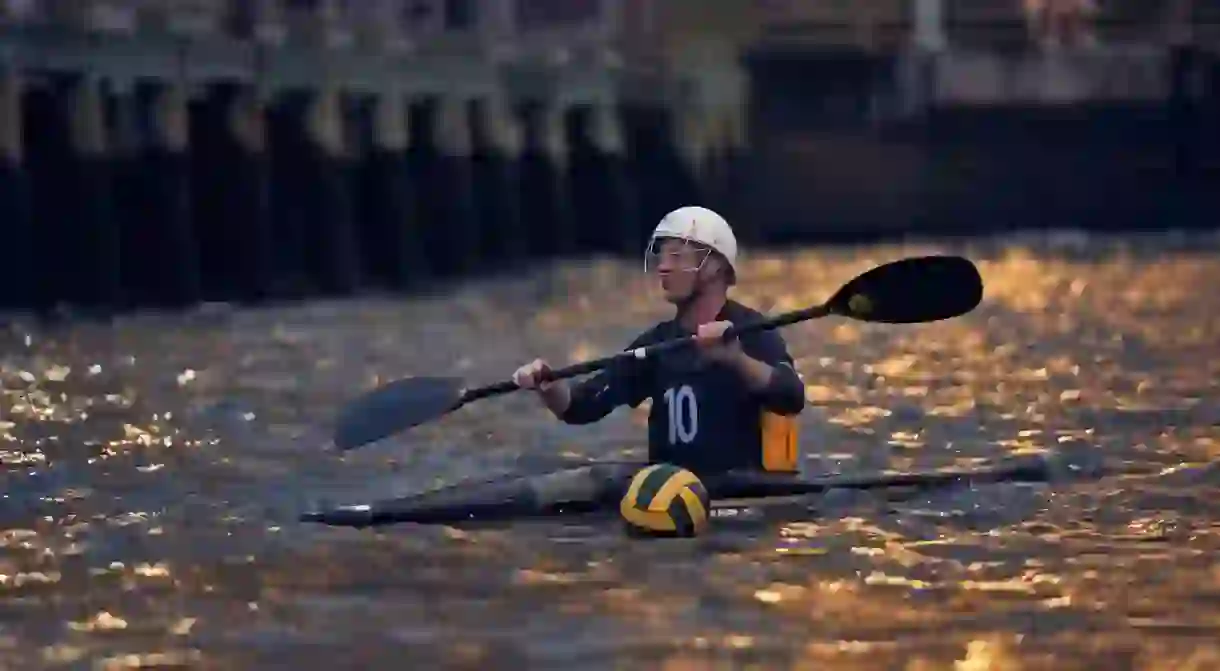Kayak Polo Hits New York City’s Waters

Kayak polo is played in 60 countries around the world, including the United States. One of the sport’s largest clubs, New York Kayak Polo, competes twice a week on the Hudson River with the city’s gleaming skyline as a backdrop.
A couple walking along the pier leans against the railing, drawn to the frenetic activity in the waters just beneath them. Later, a man on his phone pauses mid-conversation to take a picture of the same peculiar scene.
Situated comfortably between Pier 66 and Pier 66 Maritime on the Hudson River, members of New York Kayak Polo (NYKP) thrash about as the bright lights of nearby skyscrapers illuminate the water. Commands are yelled. Water is splashed. Paddles flail. A ball is thrown into a home-made net bobbing up and down on the choppy waters.

New York Kayak Polo boasts nearly 400 members on Meetup and is one of the largest kayak polo clubs in the United States. Members take to the Hudson River twice a week – depending on weather conditions, including potential sewage run-off following heavy rains – until they’re relegated to a pool in nearby Jersey City, New Jersey, during the colder winter months. New York Kayak Polo offers a variety of sessions – both in Manhattan and at its sister club in Brooklyn – for players who are just learning the sport and those who are grizzled veterans.
“It’s a fantastic escape from the everyday buzz of the city,” NYKP member Olly Gotel says. “You come out here and completely switch off from everything going on on land; all your cares and worries disappear. When you’re playing this sport you can’t think of anything else.”
Kayak polo, often referred to as canoe polo around the world, borrows the rules of water polo, but with a twist: all players are in kayaks. Two teams of five compete to score more goals than their opponents, passing the ball with their hands while navigating the designated playing field with their paddles.

The sport traces its roots as far back as 19th-century Britain, where the first canoe ball games were played. Early forms of kayak polo were played in the United States and parts of Europe in the 20th century. The International Canoe Federation (ICF) hosted the first Canoe Polo World Championships in 1994 in Sheffield, England, and the discipline made its debut at the 2005 World Games – a quadrennial international competition featuring non-Olympic sports – in Duisburg, Germany.
Most participants learn about kayak polo through other paddle sports and disciplines. Originally from Canada, New York Kayak Polo member Richard Wright was introduced to the sport when he took a canoeing course while residing in Manchester, England. His instructor was involved with the local club and gave his students a ball to throw around during practice. After moving to New York City, Wright found NYKP and continued to play.

“I just loved it from the start,” Wright says. “Canoe polo really enhanced my overall kayaking ability. It’s just so much fun. I love playing as a group and getting that dynamic going. It’s a bit of an international community. You have an automatic social group no matter where you go.”
According to the ICF, kayak polo is played in 60 countries globally. More than 530 athletes representing 27 countries participated in the 2018 Canoe Polo World Championships in Welland, Canada.
Kayak polo clubs exist across the United States in cities and areas including San Francisco, Austin, Colorado, New York, New England, Oregon and the Carolinas. The sport is played (and sometimes offered for credit) at colleges including Appalachian State University, Alaska Pacific University and the University of Washington.
Featuring teams including the San Francisco Pelicans, New York Kayak Polo and Austin Aquabats, the 2018 US Kayak Polo National Championships were held from June 23-24 on Shoreline Lake in Mountain View, California.
“There are so many people who are like, ‘What is that sport?’” Wright says. “We spend a lot of time just explaining what it is. What I hope is people see [us playing] and are inspired by it to get into kayaking.”














